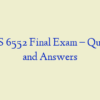Description
PSYC-2005-11-Social Influences on Behavior-2021-Winter-QTR-Term
PSYC 2005 Week 1 Quiz
- Compared to social psychologists, personality psychologists are more likely to focus their attention on:
- Social psychologists use the term to describe the subjective way in which people perceive, comprehend, and interpret their social worlds.
- Jill is eating dinner at her fiancé Rob’s parent’s house and barely touches her food. Jill is aware that his parents could make different construals of this behavior, such as:
- The tendency most people have to discount situational explanations of behavior in favor of personality characteristics or traits is called the:
- The major difference between sociology and social psychology is the:
- After the mass suicides related to the cults at Jonestown, people tended to blame the victims and accuse them of being psychologically unstable or deranged. According to the authors of your text, social psychologists are more likely to explain these mass suicides as being due to:
- Dan likes his new roommate Tim. He invites Tim to go everywhere with him—parties, lunch, even to the grocery store. Dan feels he’s being warm and welcoming to his new friend. Tim, however, doesn’t understand why it seems that Dan can’t do anything on his own, and seems to need his companionship constantly. The difference in how Dan and Tim perceive Dan’s actions is an illustration of in explaining social behavior.
- Emma wants to know if long-distance relationships in college have a greater likelihood of ending than relationships that are not long-distance. She creates a questionnaire and recruits 100 students from her school to complete the questionnaire so she can test her hypothesis. Emma is:
- Not all social influence is direct or deliberate. Which of the following is the best example of more indirect, subtle social influence?
- Lee Ross describes the idea of “naïve realism” as the:
- Capital punishment has served as a(n) deterrent to those who consider committing such crimes. This is evidenced by in the rate of capital crimes when the death penalty is enforced.
- Most of the experimental evidence regarding violent media demonstrates that watching violence increases the frequency of which of the following?
- Hostile aggression di”ers from instrumental aggression in that instrumental aggression:
- According to research presented by the authors of your text, humans’ two closest primate relatives (sharing 98 percent of DNA with humans) are the , known for their aggressive nature, and the , known for their peaceful nature.
- refers to the tendency to aggress when we perceive that our progress is thwarted.
- Which of the following is the best example of an aggressive stimulus?
- You’ve arrived half an hour late to pick up a friend. She was scheduled to take an examination, and even if you speed on the way to the university, she will now lose at least 20 minutes of the time she needs to complete the exam. According to the textbook authors, what is the best thing to say when you arrive?
- Dehumanizing an enemy (e.g., referring to Germans as “Krauts” or Japanese as “Nips” or “Japs” during World War II) can contribute to further aggression and even wartime atrocities by:
- In explaining the race riots of 1967 and 1968, Reverend Jesse Jackson noted that the riots occurred “in the middle of rising expectations and the increased, though inadequate, social spending.” His analysis best reflects as a source of aggression.
- Frustration increases the probability of an aggressive response, but does not inevitably lead to such a response (e.g., Berkowitz, 1993). A number of situational factors work to accentuate frustration, further increasing the odds of aggression. For example, frustration is accentuated when we:



